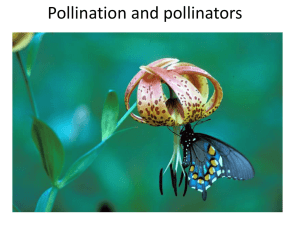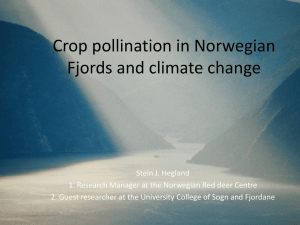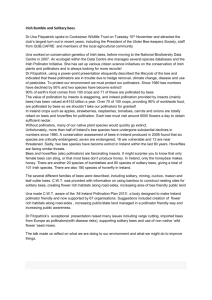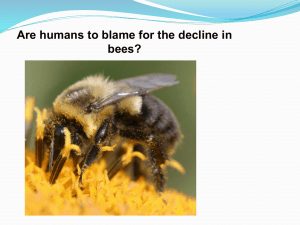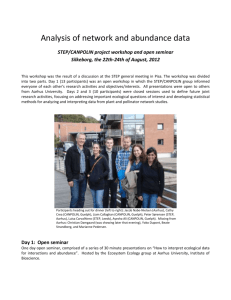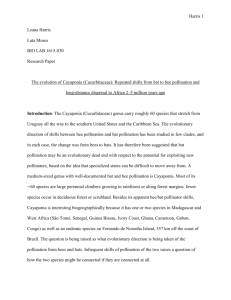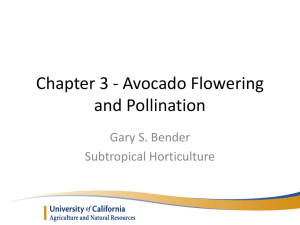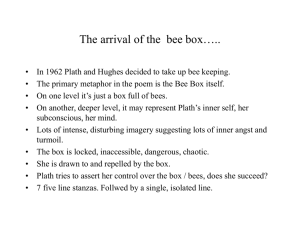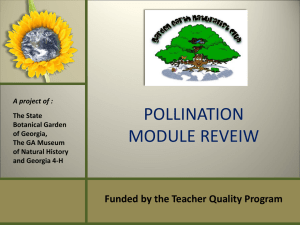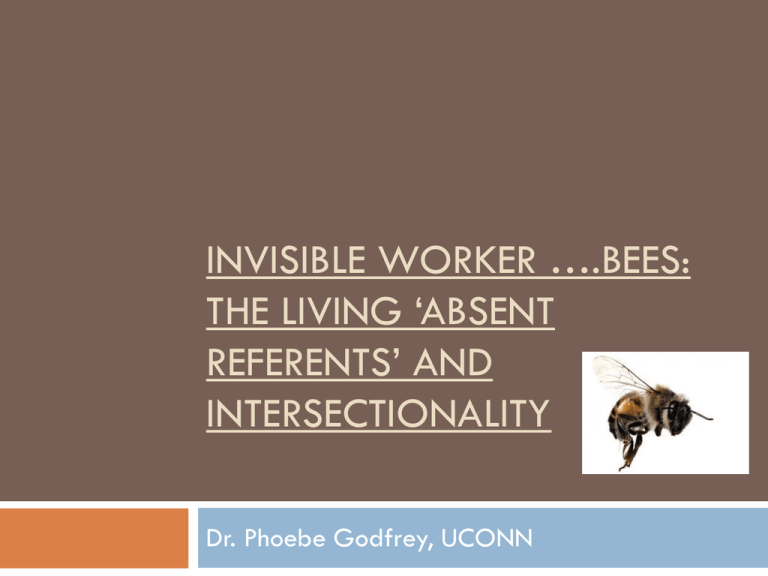
INVISIBLE WORKER ….BEES:
THE LIVING ‘ABSENT
REFERENTS’ AND
INTERSECTIONALITY
Dr. Phoebe Godfrey, UCONN
Imagine society without…
Kiwi fruit
Cranberry
Blueberry
Gooseberry
CurrantsVetches
Cherry
Pear
Plum
Apple Buckwheat
Blackberry
Orange
Lemon
Melon
Watermelon
Raspberry
Peach
Strawberry
Oil seed rape
Turnip rape
Sunflowers
Cotton
Aubergine
Lucerne (alfalfa)
Peppers
Cucumber
Squash
Pumpkin
Gourds
Celery
Coriander
Fennel
Gherkin
Marrow
Mustard
Runner beans
Lima beans
Broad beans
Soya bean
Tomato
Almonds
Theory:
Carol Adams in her 1990 book The Sexual Politics of
Meat politicized the concept of the “absent referent”.
As she states;
“Behind every meal of meat is an absence: the death of
the animal whose place the meat takes. The ‘absent
referent’ is that which separates the meat eater from
the animal and the animal from the end product. The
function of the absent referent is to keep our "meat"
separated from any idea that she or he was once an
animal, to keep the "moo" or "cluck" or "baa" away
from the meat, to keep something from being seen as
having been someone “ p. 13
Goal:
“Living Absent Referents”? Bees ?
To investigate what degree living beings can also
be considered “absent referents” in terms of their
social invisibility and to theorize a connection
between their ‘living absence’ within our social
frameworks and their increasing actual ‘absence’
due to colony collapse / death linked to industrial
agricultural practices and other invasive/destructive
practices
Method:
Casual conversations asking participants to name all
the ‘work’ that goes into the production of select
food item from apples, to almonds, to blueberries,
to watermelon…etc as I have wanted to see first if
the question produces the anticipated results, as in
the “living absent referent”
This will be expanded upon using a written listing
process but the goal is to keep the engagement
very informal so as to get more authentic responses
Conversations:
Overall the perceptions of about 50 people that I know who are
mostly foodies is that the “work” involved in food production is a
human affair.
Only four have recognized the role of pollinators- two bee keepers,
one Natural Resources major and one person who lived next to an
apple orchard in England. She recalled a story where one spring it
rained non-stop as so the bees couldn’t pollinate and there were as
a result no apples.
When given the “answer” some have replied:
“Nature doesn’t work”
“Bees are like the rain”
“Work involves wages”
“We work for them”
“Its instinct and therefore isn’t work”
Conceptions of Work?
In Spaces of Hope (2000), David Harvey quotes Marx
from Capital who states:
“We presuppose labor in a form that stamps it as exclusively human. A spider
conducts operations that resemble those of a weaver and a bee puts to shame
many an architect in the construction of her cells. But what distinguishes the worst
architect from the best of bees is this, that the architect raises his structure in
imagination before he erects it in reality…” (Harvey, 200)
However, as Harvey goes on to say now we know that
bees are very communicative and intentional in their
dances and that any comparison “seriously dents the
idea that humans are somehow at the ‘summit’ of
living things in all or even most respects.”(201-2)
Stats for Animal Pollinators:
90% of all flowering plants rely on animals, (which includes insects) rather than
the wind, for pollination
200,000 species of animals act as pollinators. The vast majority of animal
pollinators are insects such as beetles, bees, ants, wasps, butterflies and moths;
of these, bees pollinate the largest number of plant species. About 1,000
species of pollinators are hummingbirds, bats, and other small mammals.
Generally pollination happens inadvertently as a result of the animal/insect
feeding on the nectar, although some bees do eat pollen.
Honey Bees share out jobs based on their age. For instance, worker bees that
are 1-2 days old spend their time cleaning cells, starting with the one they
were born in, and keeping the brood warm; from 3-5 days old they feed older
larvae; from 6-11 days old they feed the youngest larvae; from 12-17 days
old they produce wax, build combs, carry food, and perform undertaker duties;
from 18-21 days old they get guard duty, protecting the hive entrance; from
22 days on until their death at around 40-45 days, they get to fly from the
hive collecting pollen, nectar, water, pollinating plants, and things like that.
Role of Pollinators in Human Food
Production:
About one third of what humans eat depends directly or indirectly on
pollinators (Kearns et al. as cited in Ghazoul, 2005: 387; Kluser and
Peduzzi, 2007: 354). Although production volumes of the 115 principal
world crops amount to only 35% of total crop production, the number of
crops dependent (to different degrees) on animal pollination is 87 out of
115 (Willmer, 2011: 606).
Klein et al. (2007) found that 20% of world crop production accounts for
crops with increased production of fruit and vegetables when animalpollinated, and approximately 15% accounts for crops whose seed
production increases with pollination (Klein et al., 2007: 306).
Eilers et al. (2011) found that pollinator-dependent crops hold most of the
lipids, vitamins and minerals that are necessary to prevent nutritional
deficiency. For example, 98% of the available vitamin C is present in
pollinator-dependent plants, and 58% of calcium comes from plants that
have an increased yield due to animal pollination.
Living Absent Referents Dying
In the U.S. and throughout the world, there is disturbing evidence that
many species of wild and ‘stock’ bee pollinators have decreased in
numbers because of loss of habitat, monocultures, misuse of pesticides,
introduced and invasive plants and animals, climate change and
diseases and parasites. For example, the U.S. has lost more than 50%
of its managed honey bee colonies during the past 10 years.
Research by Aizen et al. (2009) suggests that in case of complete
pollinator absence, total agricultural production is expected to decline
by 3-8%, [ on the order of 5% (developed world) to 8% (developing
world)] which means that current demands for animal-pollinated food
crops could not be met any more.
Even the limited direct reduction in agricultural production expected
under increasing pollinator shortages may impose a disproportionate
demand for agricultural land to meet growing global consumption,
which will accelerate habitat destruction and may cause further
pollinator losses.
Case Study: Hand Pollination in China
China's indigenous honeybee (Apis cerana) previously survived under varied geographical
conditions.
Recently, however, their population has decreased due to environmental pollution ad
competition from Italian bees (Apis mellifera ligustica) that were introduced to China 1900’s
With the demise of bees, pollination relies increasingly on the wind and human intervention.
Pears are a specialty of Hanyuan county, Sichuan province. Farmers here can usually harvest
about 5 tons of pears a year, but this depends on artificial pollination rather than honeybees.
Each April, the farmers collect flowers, brush and male anthers to obtain pollen, which will be
dried for two days.
Farmers tie a handful of feathers on a long bamboo pole, to imitate the hairy bodies of bees,
and the feathers are lightly dipped in pollen and then applied to flowers so they are
pollinated.
Each spring, hundreds of farmers climb up trees to pollinate flowers, one by one.
A hive of bees can pollinate 3 million flowers a day, but a person can pollinate only 30 trees.
“Isolationality” ?
My made-up word to describe a form of
‘ideological psychosis’ …which has us act under the
false assumption that identities are not fluid, that
they are not co-constructing in relation to each other
and to time and place and that humans are not
dependent on other beings, that we are not part of
nature and that society is separate from ecology…
The 45 people that I have spoken to who have not
recognized the work of bees demonstrate examples
of isolationality…..
Intersectionality? Making the ‘Absent
Referents’ Present-Living and Dead:
Intersectionality (Crenshaw, 1989; Collins, 2000)
seeks to examine how—various biological, social
and cultural categories such as sex, gender, race,
class ability, sexual orientation, SPECIES [from
wikipedia!] and other axes of identity interact on
multiple and often simultaneous levels, including the
social context / environment ….contributing to social
inequalities….but also to interdependency, synergy
and pollination
Interbeing?
This is a term used by the Buddhist Monk, Tich Nhat
Hanh to describe the Buddhist concept of
“codependent arising” (Keaton, 2002), which I see
as allowing the dynamic concept of intersectionality
to come into stasis, into being…before being
transformed again and then back to a new form of
stasis…and so on in a never ending
transformational cycle …
What You-We-Can Do?
Don’t use pesticides- seek policy changes
Buy organic- create farmer / food co-operatives
Grow your own food- grow other people’s food with
other people
Keep bees- get your towns/cities to allow bee
keeping in schools/communities
Buy local- sell local, buy in bulk, sell in bulk
Educate yourself-educate others
Recover from ‘ideological psychosis’ by changing
thinking / action from being based on isolationality,
to being based on intersectionality/ inter-bee-ing!
Present Referents!
Quote:
“The True mysTery of The world is The
visible, noT The invisible.”
Oscar Wilde
Bibliography
Aizen, MA, Garibaldi, LA, Cunningham, SA, Klein, AM (2008) Long-Term Global Trends in Crop Yield and Production
Reveal No Current Pollination Shortage but Increasing Pollinator Dependency. Current Biology, 18, pp. 1572-1575.
Crenshaw, Kimberlé (1989). Demarginalizing the intersection of Race and Sex: A Black Feminist Critique of
Antidiscrimination Doctrine, Feminist Theory and Antiracist Politics. University of Chicago Legal ForumEilers, EJ,
Collins, P.H. (2000). Gender, Black Feminism, and Black Political Economy. Annals of the American Academy of
Political and Social Science, 568. 41–53.
Demise of the bees disrupts pollination (2012) http://www.chinadaily.com.cn/cndy/201202/27/content_14696871.htm
Harvey, David (2000). Spaces of Hope, Oxford: New York
Keating, Analouise & Gloria Andeluza. (2002). This Bridge Called Home. Routledge: New York
Kremen, C, Greenleaf, SS, Garber, AK, Klein, AM (2011) Contribution of Pollinator-Mediated Crops to Nutrients in
the Human Food Supply. PLoS ONE, 6(6), pp.e21363.
Ghazoul, J (2005) Buzziness as usual? Questioning the global pollination crisis. Trends in Ecology and Evolution,
20(7), pp. 367-373.
Klein, AM, Vaissière, BE, Cane, JH, Steffan-Dewenter, I, Cunningham, SA, Kremen, C, Tscharntke, T (2007) Importance
of pollinators in changing landscapes for world crops.Proc. R. Soc. B, 274, pp. 303-313.
Kluser, S, Peduzzi, P (2007) Global Pollinator Decline: A Literature Review. UNEP/GRIDEurope.
Marcelo A. Aizen1,*, Lucas A. Garibaldi1,2, Saul A. Cunningham3 and Alexandra M. Klein4,5 (2008) “How much
does agriculture depend on pollinators? Lessons from long-term trends in crop production.” Annals of Botany
Maria Pinke (2012) “How far is world agricultural production likely to be threatened by pollinator declines?”
Sustainable Development
Willmer, P (2011) Pollination and Floral Ecology, Princeton and Oxford: Princeton University Press.
http://www.pollinator.org/Resources/facts.Primer.pdf


